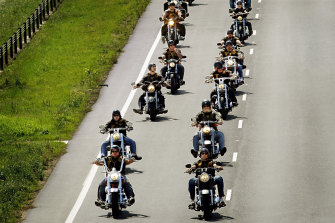Outlaw motorcycle gangs are responsible for more criminal activity in Queensland and NSW than in any other states, an Australian Institute of Criminology report has found.
The research, led by AIC principal research analyst Christopher Dowling and Serious and Organised Crime Research Laboratory research manager Anthony Morgan, found the size and economic activity of the two states were appealing for organised criminals.

The Criminal Mobility of Outlaw Motorcycle Gangs in Australia report found Queensland had 54 per cent of the offending for chapters, based on a sample size of 1923 members across 377 chapters and 35 gangs.
This was followed by NSW, which had 53 per cent, and the report showed patterns of criminal gang members moving between the two states.
Both states had the highest probability of bikies committing their next offence in a different state and territory in the country.
Dr Dowling and Mr Morgan said almost one in 10 bikies had recorded offences, excluding public order and regulatory offences, across more than one state or territory.
“Overall, more than one-third of chapters had members with offences recorded outside the jurisdictions in which they were based,” they said.
“However, most members tended to limit their offending to their own states and territories.”
Many of the OMCGs in Australia were founded in NSW, including the Comancheros, or Queensland, including the Black Uhlans and Rebels.
That was why gangs did national runs in the two states, while mother chapters continued to have headquarters within the two states.
Dr Dowling and Mr Morgan explained NSW and Queensland attracted organised crime because of the larger markets, greater resources for the manufacture, trafficking and distribution of drugs and other illegal items, and transport hubs importing and exporting.
Griffith University School of Criminology and Criminal Justice associate professor Michael Townsley said the results could suggest different enterprises of organised crime.
“A chapter in Queensland might have a large footprint in Australia but Victoria might have a local chapter, so they would have different focuses,” he said.
“The Gold Coast is a genuine tourism destination that has its own demand for illicit substances that’s a bit different, so there are push-and-pull factors operating that could explain some of the patterns that we’re seeing.”
Professor Townsley said gangs were adapting to their changing environments.
“Police are aware that many groups are highly entrepreneurial, so they’re adapting to police activity that’s restricting business models and working with new opportunities for growth,” he said.
Professor Townsley said the research was a useful “snapshot” for researchers and law enforcement.
“This is one of the first studies that’s tried to quantify the footprint of organised crime in Australia,” he said.
“It highlights the need to look at cross-border patterns. It’s very difficult to get an accurate footprint of organised crime because of its very nature [of evading] detection by authorities.”





